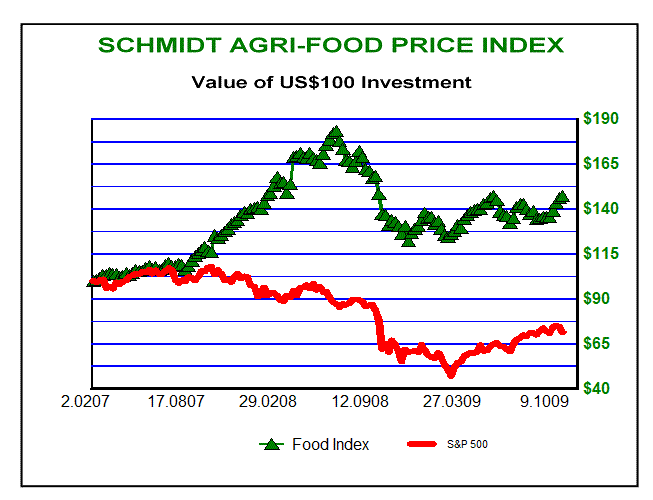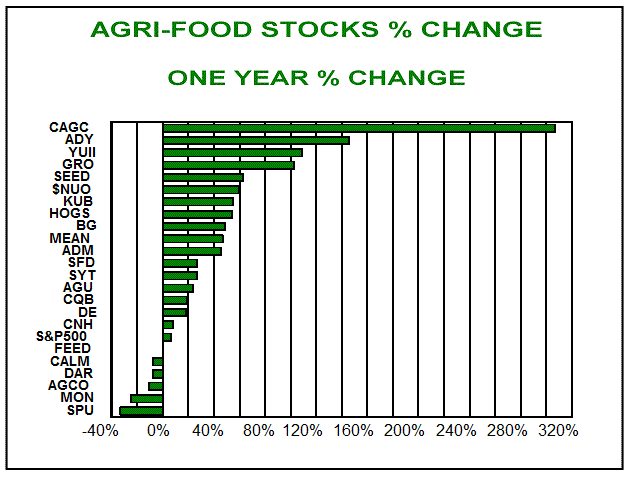Agri-Food Commodities Continue to Defy Forecasts by Trending Higher
Commodities / Agricultural Commodities Nov 02, 2009 - 06:39 PM GMTBy: Ned_W_Schmidt
 As time is moving rapidly toward the end of the calendar, thoughts tend to go to that which was accomplished during the year. Perhaps this year we might reflect on that which did not happen. A year ago, the outlook for the future was fairly gloomy. In the Western economies, the policies of the cental banks, and in particular the Federal Reserve, were abject failures. While the outlook for the Western economies continues fairly dismal, at least we do not seem to be falling further into an abyss without hope.
As time is moving rapidly toward the end of the calendar, thoughts tend to go to that which was accomplished during the year. Perhaps this year we might reflect on that which did not happen. A year ago, the outlook for the future was fairly gloomy. In the Western economies, the policies of the cental banks, and in particular the Federal Reserve, were abject failures. While the outlook for the Western economies continues fairly dismal, at least we do not seem to be falling further into an abyss without hope.
Last year was also another opportunity for many to forecast the collapse of the Chinese economy. Economists and wise seers have been forecasting the inevitable failure of that nation for decades. It just never seems to happen. For you see, per the economics community the Chinese really do not understand the proper way to guide economic activity. They need to do it like it is done in the U.S. and the UK. The brilliance of the advice to China by Western experts can be seen in the red line in the chart below which represents the performance of the S&P 500. Does that negative slope demonstrate economic wisdom? Little wonder the Chinese listen little to them.

Agri-Food commodities also continue to defy the forecasts of a year ago. As pictured in the chart above, Agri-Food commodities did not go to “zero.” Indeed, an investor would have faired far better with a basket of Agri-Food commodities than with an investment in the U.S. stock market. As the years pass, and that performance gap continues to be apparent, investors will be drawn to perhaps the dominant investment theme of the decade.
The secular growth in the global demand for Agri-Food seems to becoming again dominant. Even after being pummeled by the collapse of the hedge fund mania, commodity prices remain above the level that preceded that period. On average, Agri-Food prices are above those that existed some three years ago. Which technology companies can say the same about either the prices of their products or the price of their stocks?
Part of the reason for this development is that the average cost curve for Agri-Foods is rising. At the margin, the next unit of Agri-Food production is a more expensive unit. That situation contrasts with consumer electronics where the average cost curve is declining. The next unit of a consumer electronics product costs less.
At the same time the global demand for Agri-Foods has positive “creep.” Each day the world adds people, ones expecting to eat each and every day of their lives. Each day Chinese workers are moving up the income ladder, and will consume a higher quantity of higher value Agri-Foods. But none of this is reported. No monthly report on global Agri-Food demand is released to be compared to consensus estimates. Despite that, it is happening and being reflected in rising Agri-Food prices.
Sometimes the shift in demand is observable. Commodity News for Tomorrow, 5-6 October 2009, reported that the UK will become a net importer of wheat next year, for the first time in history. And please note, the UK has a long history. By the end of next year, biofuels plants in the UK will consume 2 million tons of wheat annually, forcing that country to become a net importer of wheat. That semi permanent shift in demand means an additional 2 million of wheat to be consumed EVERY year.
Mother Nature also did her part to tighten the global supply-demand situation this past year. Floods followed the Indian monsoons. The Philippines managed to be the bull’s eye target for several typhoons. While an immediate loss of Agri-Food production occurs with such events, a permanent impact on the supply of food must also be acknowledged. Those torrential rains washed away topsoil that will never be replaced. The world’s ability to supply Agri-Food was lowered another small notch by these storms. Agri-Food is produced in dirt, not in factories.

However, with every situation some beneficiaries can be found. In our second chart above is portrayed the performance of a basket of Agri-Food stocks over the past year. Some of them did quite nicely. While past performance is certainly no prediction of future performance, we do note that most of the world will continue to eat over time. They may not need a new computer, but they will need to restock the refrigerator. These companies will be dipping their beaks in that money flowing to pay for that food.
The UK’s shift to being a net importer of wheat, mentioned above, has many subtleties and nuances for investors to consider. First and foremost, rather than paying some oil kingdom despots, an undeserving group, for oil, they will be paying farmers, a deserving group, for their grain. UK cannot import productive land or fresh water. However, importing the grain is the economic equivalent of importing productive land and fresh water. And in reverse will flow money from the UK to the producers of those grains, a well deserving group.
The UK has historically been the model for the consuming nation in the global Agri-Food system. China is implementing a version of that model. In the 19th century, the UK discovered the solution to feeding its population. It became a net imported of food at that time. The key was for the population to earn sufficient income to simply buy the food on world markets. Likewise, China has discovered that feeding its citizens is not solely about producing food. Give them sufficient income, and they will simply buy the food on world markets. Is your portfolio prepared to benefit from 1.3 billion Chinese buying more food on world markets over the next decade? To begin your research use this link: http://home.att.net/~nwschmidt/Order_AgriValueRECENT.html
We continue to be excited with the response to 3rd Annual U.S. Agricultural Land As An Investment Portfolio Consideration, 2009 which was recently released. This work is the definitive annual study of the role of U.S. agricultural land in an investment portfolio. It is a rigorous statistical analysis suitable for the sophisticated investor. The 60 page PDF file is delivered via email, and is available at the following link: http://home.att.net/~nwschmidt/OrderAgriLand2009.html
By Ned W Schmidt CFA, CEBS
AGRI-FOOD THOUGHTS is from Ned W. Schmidt,CFA,CEBS, publisher of The Agri-Food Value View , a monthly exploration of the Agri-Food grand cycle being created by China, India, and Eco-energy. To receive the most recent issue of this publication, use this link: http://home.att.net/~nwschmidt/Order_AgriValue.html
Copyright © 2009 Ned W. Schmidt - All Rights Reserved
Ned W Schmidt Archive |
© 2005-2022 http://www.MarketOracle.co.uk - The Market Oracle is a FREE Daily Financial Markets Analysis & Forecasting online publication.



